Menus
- Don’t complain, work!
- Yamaha YZF-R1 consumes 6.1 liters
- Tears almost unbelievable, sounds relaxed
- "Are you still cornering stable or already stubborn?"
- Bent over, hanging next to the front wheel
- Assistance systems of the Yamaha YZF-R1
- ABS of R1 cannot be switched off
- Control processes noticeable but not disruptive
- Technical data: Yamaha YZF-R1
- Switch and rule
- The core of the electronics package consists of the YRC settings
- Aprilia RSV4 RR
- BMW S 1000 RR
- Ducati Panigale 1299 S.
- Conclusion
- Offers for the Yamaha YZF-R1
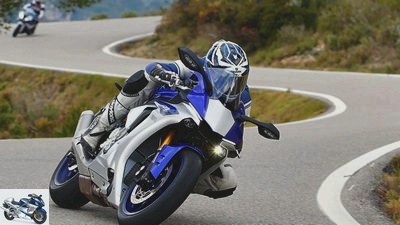
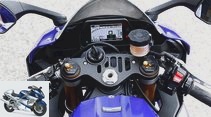

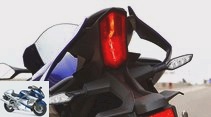
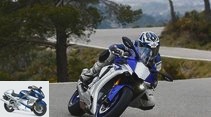
27 photos
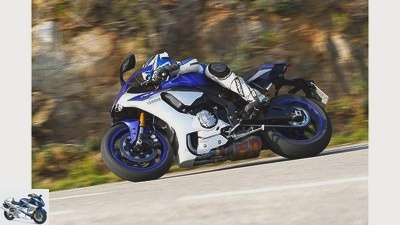
1/27
After six years, Yamaha has completely redesigned the sporty top model. The new YZF-R1 now has a completely different character.
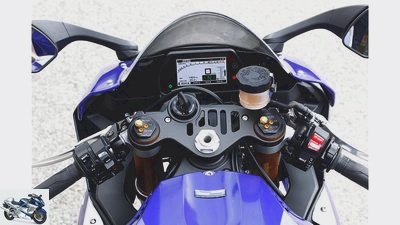
fact
2/27
Here the display in street mode, it can also be switched to race mode.
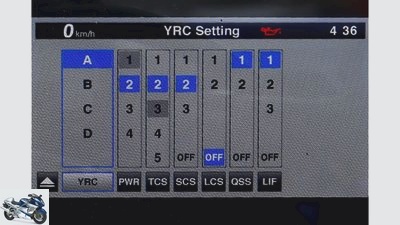
3/27
In this picture the display shows an overview of all settings.
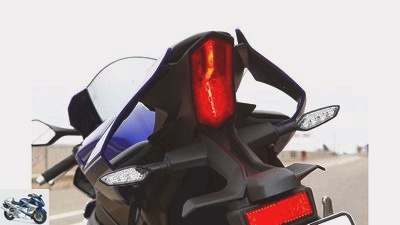
4/27
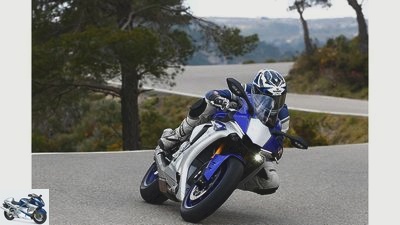
5/27
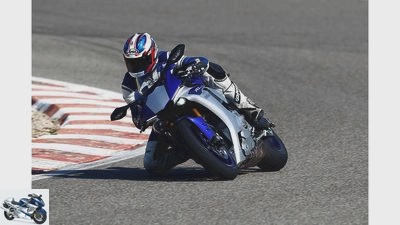
6/27
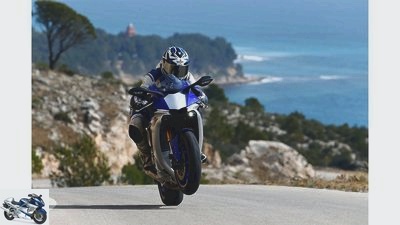
7/27
If the engine really goes off in first gear from around 7000 rpm, the driver can simply stop using the lift control.
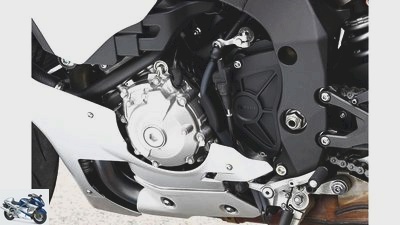
8/27
Positive: Reversing the circuit diagram is easy to do with the R1. You only have to move the lower eye of the shift rod from the front screw point of the shift lever to the rear. The driver should then also attach a warning sticker in the cockpit, which reminds of the modification.

9/27
Negative (I): Normal racing boots and driving a few kilometers are enough to scratch the rocker arm. A cover would be helpful.
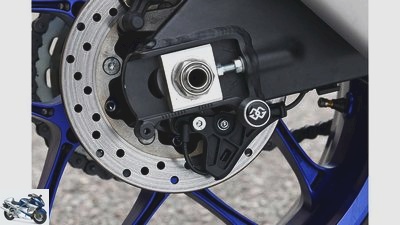
10/27
Negative (II): When threading the rear brake after changing a tire, it was noticed that the ABS sensor cable can easily be pulled out of its holder. Then it rubs against the brake disc. Meticulous control is necessary.
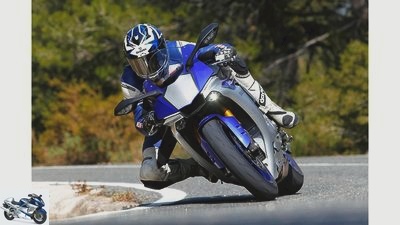
11/27
This is not a posing, but a sitting position in which the R1 can be directed smoothly. And extremely precise.
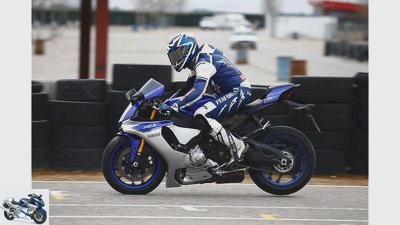
12/27
Most of the emergency braking takes place in this position.
Nevertheless, the motorcycle stays in lane when braking straight ahead.
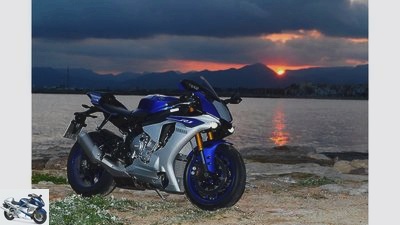
13/27
The R1 unfolds its potential on the racetrack, while on winding roads it demands sensitive work on the throttle.
Incidentally, it is not suitable for off-road use – the picture meets purely aesthetic requirements.
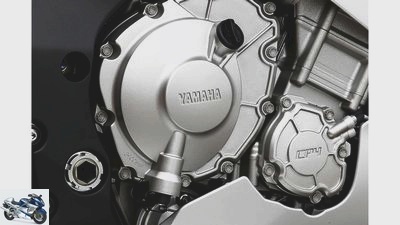
14/27
Compact engine construction: The abbreviation CP4 stands for the crossplane four-cylinder with a 90 degree crank pin offset
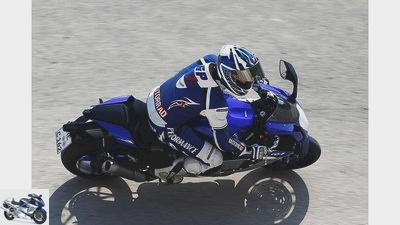
15/27
The top test shows that the R1 demands a lot, but can also give a lot.
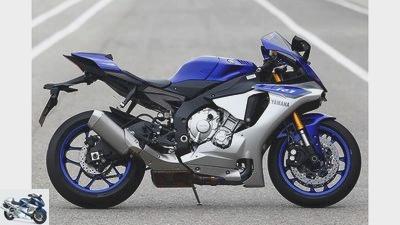
16/27
The new Yamaha YZF-R1 (I).
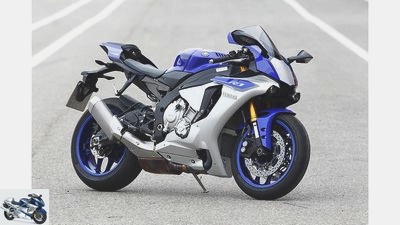
17/27
The new Yamaha YZF-R1 (II).
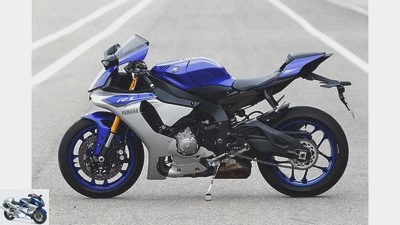
18/27
The new Yamaha YZF-R1 (III).

19/27
The new Yamaha YZF-R1 (IV).
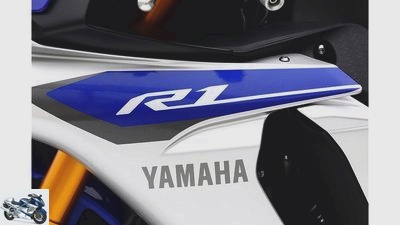
20/27
The new Yamaha YZF-R1 (V).

21/27
The one-piece brake calipers are machined from one side and sealed with plugs.
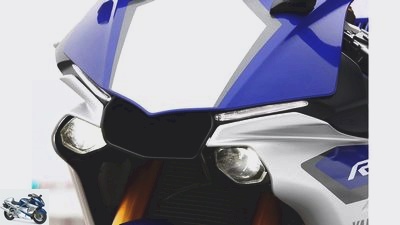
22/27
The large central air inlet requires unusual headlights. Their light output is decent.

23/27
Fork setup, appetizingly presented. Nobody can say more, …

24/27
… the adjusting screws are difficult to achieve.
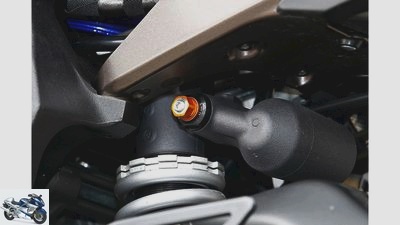
25/27
It is the same with the shock absorber.
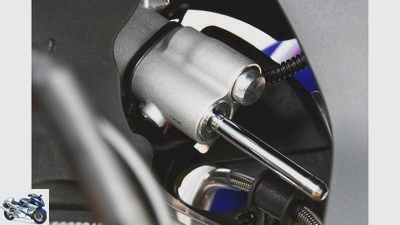
26/27
The electronic steering damper makes an important contribution to the unshakable stability of the R1.
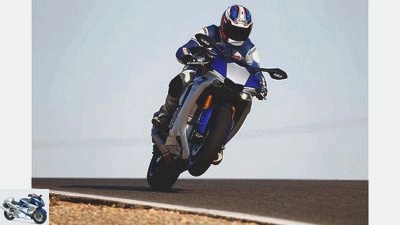
27/27
Yamaha YZF-R1 in the top test
Don’t complain, work!
After six years, Yamaha has completely redesigned the sporty top model, the YZF-R1. The result was a motorcycle with a radically changed character. The top test showed that the Yamaha YZF-R1 demands a lot, but can also give a lot.
How much M1 is in the Yamaha YZF-R1? How much of the legendary MotoGP Yamaha Jorge Lorenzos and Valentino Rossis has gone into the brand’s newest female super athlete? More than ever, even in terms of design. The distinctive central inlet for the intake air, the start number field above, the entire shape of the front fairing are closely based on the appearance of the YZR-M1. “I am a racing motorcycle of the purest kind, built to be fast,” is the announcement.
Buy complete article
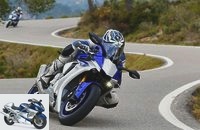
Yamaha YZF-R1 in the top test
Don’t complain, work!
199 kilograms with a full tank
So the effort to create a completely new engine for the Yamaha YZF-R1 was worth it. A brief summary of the most important changes shows how much effort Yamaha has put in: The new engine has one millimeter more bore and 1.3 millimeters less stroke than the previous model. This enables larger valve diameters and better filling. The new cylinder head is an even bigger step in the direction of racing technology: Instead of bucket tappets, the valves are now operated using light rocker arms – as in the MotoGP class. Not to mention fine components such as titanium connecting rods and forged pistons.
As a further indication of the enormous progress that the new Yamaha YZF-R1 represents, two further comparative figures should be mentioned: 215 and 199 kilograms. This is how much both motorcycles weigh, the old and the new with a full tank. It should be noted that the old R1 had no ABS and its tank was only one liter larger than the new one. The reduction from 18 to 17 liters only saves around 0.8 of a total of 16 kilograms. Most likely, there is not a single part on the new R1 that is not lighter than the comparable one on the old one.
All tests and articles about the Yamaha YZF-R1
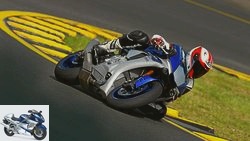
Super athlete
Yamaha YZF-R1 in the driving report
The Empire Strikes Back
read more
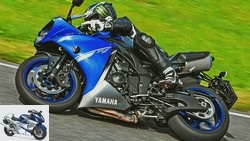
Super athlete
Zonko’s attack on the Yamaha YZF-R1
Too fat for this world
read more
Yamaha YZF-R1 consumes 6.1 liters
Only when it comes to pulling power does the new Yamaha YZF-R1 find it difficult to set itself apart from its older sister. In fact, the measured values do not give any reason for a lazy driving style at low speeds in high gears. And although this was exactly what was practiced on fuel consumption, the R1 engine allowed itself to be 6.1 liters per 100 kilometers. If you could fully use the 17 liter tank capacity, you would get 279 kilometers. However, a self-sacrificing self-experiment has shown that about one liter of petrol cannot be used, so the actual range is reduced accordingly. At a constant 130 km / h, the R1 swallows only 5.5 liters.
The reason for the mediocre draft lies in the engine characteristics: Up to around 7000 rpm, the Yamaha four-cylinder seems to be deliberately slowed down. The steep increase in torque between 7200 and 8800 rpm is then, however, extremely spectacular and feels that way. At these speeds, you are already driving in third gear on the country road, far beyond your driver’s license. And as quiet as the crossplane four-cylinder may run and sound, the response is rough, at least in power modes one and two. The numerous load changes on winding roads require concentrated, sensitive work on the throttle. In mode three, the engine of the new Yamaha YZF-R1 accelerates a little more gently after coasting, but here the even lower torque in the middle is noticeable even when driving in public traffic.
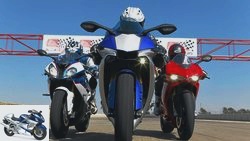
Super athlete
BMW S 1000 RR, Ducati 1299 Panigale S and Yamaha YZF-R1 in a comparison test
Circuit comparison
read more
To the registration page for the Yamaha YZF-R1M
Tears almost unbelievable, sounds relaxed
It’s trips to the autobahn, and better still the race track, that allow the engine of the new Yamaha YZF-R1 to unfold its full power and glory. And his very special way of tricking the driver’s perception into making it easier for him to drive fast. Because even under full load close to the performance zenith, when the four-cylinder cracks almost unbelievably, it still sounds calm, relaxed. This not only tempts you to use the rich range of services, but also helps to keep the driver’s focus on the important things. Beyond all measured values, this is one of the great advantages of the crossplane principle.
At least since Valentino Rossi’s first world championship on a Yamaha, the M1 chassis have been regarded as exceptionally good, as the top of the line. We don’t know what the new Yamaha YZF-R1 may have copied from them. The fact that it has an excellent chassis can be seen after the first few turns. It lies incredibly well on the front wheel, finds its curve path with the highest precision and does not allow itself to be unbalanced by the harsh load change at the apex. In the acceleration phase it gives the feeling of a precisely leading, neatly resilient hindquarters. That already captivates you when driving fast country roads for the Yamaha YZF-R1 and can really inspire on the racetrack.
"Are you still cornering stable or already stubborn?"
The test team allowed themselves a short excursion from the hinterland of the Spanish coastal town of Cambrils to the Circuito de Alcarràs. One of the specialties of this race course consists of a fast, steeply downhill double left curve in which several long and deep bumps are embedded. It is in such passages that the Yamaha YZF-R1 shows its greatest strength: It guarantees the driver that there will be no problems with the front wheel and that the bumps will never take him off course. You would probably even feel a front wheel slide so early and unadulterated that you could still catch it.
These virtues are not to be confused with a playful handiness and are not necessarily compatible with them. The Yamaha demands strong steering impulses, especially in changing bends. As if proof had been needed after countless country road curves, the narrow left-right chicane in Alcarràs delivered it in an impressive manner. “Are you still cornering stable or are you already stubborn?” The Yamaha YZF-R1 is asked with regard to this section, but it replies unmoved: “Don’t complain, work.”
Bent over, hanging next to the front wheel
Yes exactly. The price for the chassis qualities of the Yamaha YZF-R1 is to be paid with physical work in the form of high steering forces or dynamic weight shifting. Because it curves best when the driver sits down low, better still hanging next to the inside of the curve of the front wheel.
In any case, leaning on the handlebars with your elbows pushed in is not recommended. The Yamaha YZF-R1 cannot be steered smoothly from such a sitting position. With its high seat and low handlebars, it brings a lot of rider weight forward. A comparison value: The Ducati 916, which is considered extreme, carried the handlebar grips a good four centimeters higher than the seat, the R1 around 3.5 centimeters. The driver has to keep his weight out of the abdominal and back muscles when driving slowly, according to R1 standards, i.e. at country road speed – and that becomes tiring in the long run. Over time, the slogan of a well-known DIY chain is changed: There is always a lot to do. For hardcore racer drivers who are always on the road with full commitment, that goes without saying. But the majority of supersport motorcycles are still used most of the time in public transport.
Assistance systems of the Yamaha YZF-R1
Highly engineered motorcycles can hardly be recognized without their assistance systems being appreciated. Despite the complexity of these systems and even though some of their components can be adjusted in many stages (for operation see next article pages), the Yamaha YZF-R1 does not make it as difficult to find your way around them as it initially seems. You can tell that there is a lot of development work behind this complex too.
The most likely to feel the differences between the four power modes during routine drives, which are sorted after a short test period. The MOTORRAD testers chose mode one for the racetrack, otherwise one or two. The traction control of the Yamaha YZF-R1, which can be set in nine stages, was set to two for the racetrack and mostly three for the country road. This setting allows quite a lot of slip on the rear wheel; those who like it more defensive should choose four or five. Attention: If you switch off the traction control, you also automatically deactivate the drift and wheelie control. As far as this Slide-Control SCS is concerned, even ambitious sports drivers should get along well with level two out of three, level one would allow those who need it more drift angles.
ABS of R1 cannot be switched off
On the rising and undulating home straight of the Alcarràs course, the author preferred the lift control in level one when accelerating fully, which allows nice acceleration wheelies despite the increased safety. It can remain in this level without any problems even when driving on country roads. And please don’t let anyone believe that you don’t need them there. The differences between the two shift assistant modes were so small that they seem insignificant.
When it comes to ABS, Yamaha does not allow any deviations from the factory settings. The anti-lock braking and combined braking system cannot be switched off either. Unusual for a super athlete. As already indicated on the country road and confirmed on the race track, the braking system is not the limiting factor when braking into corners, but rather the mounting of the rear wheel. When braking straight ahead with the clutch pulled, the Yamaha YZF-R1 stays neatly on track, even with a light gap between the rear tire and the road.
As announced in the manual, the control processes are noticeable, but do not interfere. The average deceleration from 100 km / h is flawless at 9.4 m / s². But if you want to shift down when braking on the racetrack and / or also want to brake into the curve, you have to do this very carefully, otherwise you will often find yourself with the rear end exposed far outside the targeted line with the Yamaha YZF-R1.
It cannot be due to the tuning of the fork. It offers a firm spring and steep progression, and more preload would make the Yamaha YZF-R1 even more sluggish. The same applies to lowering the stern by lowering the spring preload. The reason for the rise of the rear is probably to be found in the extremely front-wheel-oriented seating position. Suspension specialists could try this or that, but for the time being it will probably be more useful to practice a special braking technique: not abruptly, but still late and moderately well into the corners. As the pros do. It fits the Yamaha YZF-R1 to make such demands. It probably got that from the M1 too.
Control processes noticeable but not disruptive
As announced in the manual, the control processes are noticeable, but do not interfere. The average deceleration from 100 km / h is flawless at 9.4 m / s². But if you want to shift down when braking on the racetrack and / or also want to brake into the curve, you have to do this very carefully, otherwise you will often find yourself with the rear end exposed far outside the targeted line with the Yamaha YZF-R1.
It cannot be due to the tuning of the fork. It offers a firm spring and a steep progression, and more preload would make the Yamaha YZF-R1 even more sluggish. The same applies to lowering the rear end by lowering the spring preload. The reason for the rise of the rear is probably to be found in the extremely front-wheel-oriented seating position. Suspension specialists could try this or that, but for the time being it will probably be more useful to practice a special braking technique: not abruptly, but still late and moderately well into the corners. As the pros do. It fits the Yamaha YZF-R1 to make such demands. It probably got that from the M1 too.
Technical data: Yamaha YZF-R1
The switching pattern is reversed in a jiffy. 🙂
Reversing the circuit diagram is easy to do on the Yamaha YZF-R1. You only have to move the lower eye of the shift rod from the front screw point of the shift lever to the rear. The driver should then also attach a warning sticker in the cockpit, which reminds of the modification.
The swing arm is also scratched in no time. 🙁
Normal racing boots and a few kilometers of driving are enough to scratch the swingarm of the Yamaha YZF-R1. A cover would be helpful.
And if the ABS sensor cable slips out in no time at all, then it is broken in no time.
When threading the rear brake after changing a tire, it was noticed that the ABS sensor cable can be easily pulled out of its holder. Then it rubs against the brake disc. Meticulous control is necessary.
Switch and rule
All settings can be changed quickly and easily using the rotary menu switch in the display.
A driver’s manual used to be reading, now it is almost a study. The German manual for the Yamaha YZF-R1 comprises 134 pages, 36 of which describe the choice of electronic driving aids and display options.
But don’t worry, the menu navigation of the Yamaha YZF-R1 is exemplary and clear, without incapacitating the driver by overly simplifying it. Specialists will find plenty of options for configuring their motorcycle according to different needs. If necessary, these previously created configurations can be activated quickly. In order not to distract the driver’s attention from the traffic situation, such a change is only possible when the vehicle is stationary.
The core of the electronics package consists of the YRC settings
The display provides a clear representation of the settings for all four driving modes.
These are the settings of the so-called Yamaha Riding Control.
They are divided into four modes from A to D, and for each mode the individual components – traction control, engine characteristics, drift control, shift assistant and racing start aid – can be selected in different stages. You can put together a race track mode A with little traction control intervention, a strong drift angle and fast shift times, configure a mild country road mode under B and one for driving in the rain under C. Or, if you share a Yamaha YZF-R1, you can have your own mode ready for each of several riders. All of this works with a few twisting and pushing movements on the menu switch on the right. Once the modes have been put together, they can be easily activated with the mode switch group on the left end of the handlebar. It even allows the individual functions to be reconfigured quickly, in the case of TCS and SCS even while driving. The VRC Setting table, in which changes can also be made, offers a quick overview of which system intervenes and in which mode.
Displays such as the two trip meters, current or average consumption can also be called up and reset while driving using the rotary menu switch.
Aprilia RSV4 RR
Competitor 1: The Aprilia RSV4 RR.
Four-cylinder V-engine with 201 hp
Weight 199 kg
0-100 km / h n / a.
Vmax 290 km / h
Consumption n / a.
18490 euros *
All articles about the Aprilia RSV4 RR
BMW S 1000 RR
Competitor 2: The S 1000 RR from BMW.
Four-cylinder in-line engine with 199 hp
Weight 205 kg
0-100 km / h 3.2 sec
Vmax 299 km / h
Consumption 5.7 liters
17,200 euros

Super athlete
BMW S 1000 RR, Ducati 1299 Panigale S and Yamaha YZF-R1 in a comparison test
Circuit comparison
read more
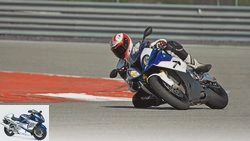
Super athlete
BMW S 1000 RR in the driving report
Heavily revised Bayern Express
read more
Ducati Panigale 1299 S.
Competitor 3: The 1299 Panigale S from Ducati.
Two-cylinder V-engine with 205 hp
Weight 194 kg
0-100 km / h 3.2 sec
Vmax 299 km / h
Consumption 5.8 liters
25,490 euros

Super athlete
Ducati 1299 Panigale S and Ducati 1199 Panigale S in comparison test
What can the new one do better??
read more
All tests and articles about the Ducati 1299 Panigale S.
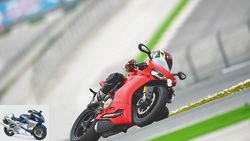
Super athlete
Ducati 1299 Panigale S in the driving report
Sports cannon through and through
read more
Conclusion
More of a case for the racetrack? – The new Yamaha YZF-R1.
A lot of top performance, a comparatively weak middle and tough response. A chassis that is trimmed for extreme precision and stability and demands full commitment from the driver. A wide range of assistance systems that are easy to use. High quality components, solid workmanship. A reasonable price given what is on offer. This is – in a nutshell – the new Yamaha YZF-R1.
Offers for the Yamaha YZF-R1
Used Yamaha YZF-R1 in Germany
The first-class road racing machine is very popular and can often be found on the used motorcycle market. There are many Yamaha YZF-R1 in top condition and at reasonable prices: Used Yamaha YZF-R1 in Germany
Related articles
-
Comparison test BMW S 1000 RR, Ducati 1299 Panigale S and Yamaha YZF-R1
fact 46 photos fact 1/46 Yamaha YZF-R1. fact 2/46 BMW S 1000 RR. fact 3/46 The swing arm takes the wheel axle very far back – good for driving stability….
-
BMW S 1000 RR and Yamaha YZF-R1 in comparison test
fact 31 photos fact 1/31 Yamaha YZF-R1. fact 2/31 On both motorcycles, reversing the shift pattern is a minor matter … fact 3/31 … this is kindly…
-
Yamaha FJR 1300 Tourer in the test
fact 38 photos fact 1/38 Yamaha FJR 1300 in the top test. fact 2/38 Yamaha FJR 1300 in the top test. fact 3/38 Yamaha FJR 1300 in the top test. fact 4/38…
-
Comparison test Kawasaki Z 900, MV Agusta Brutale 800 RR Yamaha MT-09 SP
fact / Joachim Schahl 21st photos fact / Joachim Schahl 1/21 Kawasaki Z 900, MV Agusta Brutale 800 RR and Yamaha MT-09 SP promise undisguised driving…
-
BMW, Kawasaki, Triumph and Yamaha Tourer in comparison test
Gargolov 31 photos Gargolov 1/31 Tourer comparison test: Triumph Trophy SE, BMW R 1200 RT, BMW K 1600 GT, Yamaha FJR 1300 and Kawasaki 1400 GT. Gargolov…
-
Aprilia RSV4 RF and Yamaha YZF-R1M in comparison test
40 photos markus-jahn.com 1/40 Aprilia RSV4 RF and Yamaha YZF-R1M in comparison test. markus-jahn.com 2/40 You sit quite high on both bikes, but with the…
-
Yamaha FZR 1000 Genesis versus Yamaha YZF-R1
Yamaha FZR 1000 Genesis versus Yamaha YZF-R1 Yamaha’s thousands: the trendsetters With 135 hp in the unthrottled version, five-valve technology, cylinder…
-
Single test: Yamaha YZF-R6 The revised Yamaha YZF-R6 Content of The R6 has largely retained its radically racing look – except for the…
-
Gargolov Top test Yamaha XT 660 R Still single? The abbreviation XT has stood for adventure and pack mule for decades. Now the new one is here. With…
-
Endurance test interim balance of the Yamaha XT 1200 Z Super Tenere
Photo: j.kuenstle.de 20th photos 1/20 The Yamaha XT 1200 Z Super Tenere doesn’t care about its goals: whether for camping in the Allgau, in a hotel in…